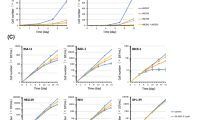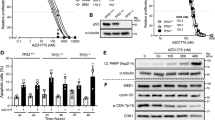Abstract
Objective
In B-cell acute lymphoblastic leukemia (B-ALL), current intensive chemotherapies for adult patients fail to achieve durable responses in more than 50% of cases, underscoring the urgent need for new therapeutic regimens for this patient population. The present study aimed to determine whether HZX-02-059, a novel dual-target inhibitor targeting both phosphatidylinositol-3-phosphate 5-kinase (PIKfyve) and tubulin, is lethal to B-ALL cells and is a potential therapeutic for B-ALL patients.
Methods
Cell proliferation, vacuolization, apoptosis, cell cycle, and in-vivo tumor growth were evaluated. In addition, Genome-wide RNA-sequencing studies were conducted to elucidate the mechanisms of action underlying the anti-leukemia activity of HZX-02-059 in B-ALL.
Results
HZX-02-059 was found to inhibit cell proliferation, induce vacuolization, promote apoptosis, block the cell cycle, and reduce in-vivo tumor growth. Downregulation of the p53 pathway and suppression of the phosphoinositide 3-kinase (PI3K)/AKT pathway and the downstream transcription factors c-Myc and NF-κB were responsible for these observations.
Conclusion
Overall, these findings suggest that HZX-02-059 is a promising agent for the treatment of B-ALL patients resistant to conventional therapies.
Similar content being viewed by others
References
Malard F, Mohty M. Acute lymphoblastic leukaemia. Lancet, 2020,395(10230):1146–1162
Graux C. Biology of acute lymphoblastic leukemia (ALL): clinical and therapeutic relevance. Transfus Apher Sci, 2011,44(2):183–189
Leonard J, Stock W. Progress in adult ALL: incorporation of new agents to frontline treatment. Hematology Am Soc Hematol Educ Program, 2017,2017(1):28–36
Ribera JM, Garcia O, Gil C, et al. Comparison of intensive, pediatric-inspired therapy with nonintensive therapy in older adults aged 55–65 years with Philadelphia chromosome-negative acute lymphoblastic leukemia. Leuk Res, 2018,68:79–84
DeAngelo DJ, Stevenson KE, Dahlberg SE, et al. Long-term outcome of a pediatric-inspired regimen used for adults aged 18–50 years with newly diagnosed acute lymphoblastic leukemia. Leukemia, 2015,29(3):526–534
Huang W, Sun X, Li Y, et al. Discovery and Identification of Small Molecules as Methuosis Inducers with in Vivo Antitumor Activities. J Med Chem, 2018,61(12):5424–5434
Feng L, Chen K, Huang W, et al. Pharmacological targeting PIKfyve and tubulin as an effective treatment strategy for double-hit lymphoma. Cell Death Discov, 2022,8(1):39
Sbrissa D, Ikonomov OC, Shisheva A. Phosphatidylinositol 3-phosphate-interacting domains in PIKfyve. Binding specificity and role in PIKfyve. Endomenbrane localization. J Biol Chem, 2002,277(8):6073–6079
Stenmark H, Aasland R, Toh BH, et al. Endosomal localization of the autoantigen EEA1 is mediated by a zinc-binding FYVE finger. J Biol Chem, 1996,271(39):24048–24054
Kim SM, Roy SG, Chen B, et al. Targeting cancer metabolism by simultaneously disrupting parallel nutrient access pathways. J Clin Invest, 2016,126(11):4088–4102
Krishna S, Palm W, Lee Y, et al. PIKfyve Regulates Vacuole Maturation and Nutrient Recovery following Engulfment. Dev Cell, 2016,38(5):536–547
Gayle S, Landrette S, Beeharry N, et al. Identification of apilimod as a first-in-class PIKfyve kinase inhibitor for treatment of B-cell non-Hodgkin lymphoma. Blood, 2017,129(13):1768–1778
Janke C, Magiera MM. The tubulin code and its role in controlling microtubule properties and functions. Nat Rev Mol Cell Biol, 2020,21(6):307–326
Wloga D, Joachimiak E, Fabczak H. Tubulin Post-Translational Modifications and Microtubule Dynamics. Int J Mol Sci, 2017,18(10):2207
Florian S, Mitchison TJ. Anti-Microtubule Drugs. Methods Mol Biol, 2016,1413:403–421
Maltese WA, Overmeyer JH. Methuosis: nonapoptotic cell death associated with vacuolization of macropinosome and endosome compartments. Am J Pathol, 2014,184(6):1630–1642
Overmeyer JH, Young AM, Bhanot H, et al. A chalcone-related small molecule that induces methuosis, a novel form of non-apoptotic cell death, in glioblastoma cells. Mol Cancer, 2011,10:69
Sorger PK, Dobles M, Tournebize R, et al. Coupling cell division and cell death to microtubule dynamics. Curr Opin Cell Biol, 1997,9(6):807–814
Horio T, Murata T. The role of dynamic instability in microtubule organization. Front Plant Sci, 2014,5:511
Vandenabeele P, Galluzzi L, Vanden Berghe T, et al. Molecular mechanisms of necroptosis: an ordered cellular explosion. Nat Rev Mol Cell Biol, 2010,11(10):700–714
Visvader JE. Cells of origin in cancer. Nature, 2011,469(7330):314–322
Liu JS, Huo CY, Cao HH, et al. Aloperine induces apoptosis and G2/M cell cycle arrest in hepatocellular carcinoma cells through the PI3K/Akt signaling pathway. Phytomedicine, 2019,61:152843
Wang BJ, Zheng WL, Feng NN, et al. The Effects of Autophagy and PI3K/AKT/m-TOR Signaling Pathway on the Cell-Cycle Arrest of Rats Primary Sertoli Cells Induced by Zearalenone. Toxins (Basel), 2018,10(10):398
Li H, Dan C, Gong X, et al. Sorghumol triterpene inhibits the growth of circulating renal cancer cells by promoting cell apoptosis, G2/M cell cycle arrest and downregulating m-TOR/PI3K/AKT signalling pathway. J BUON, 2019,24(1):310–314
Dolcet X, Llobet D, Pallares J, et al. NF-kB in development and progression of human cancer. Virchows Arch, 2005,446(5):475–482
Haupt Y, Rowan S, Shaulian E, et al. p53 mediated apoptosis in HeLa cells: transcription dependent and independent mechanisms. Leukemia, 1997,11 Suppl 3:337–339
Thompson EB. The many roles of c-Myc in apoptosis. Annu Rev Physiol, 1998,60:575–600
McMahon SB. MYC and the control of apoptosis. Cold Spring Harb Perspect Med, 2014,4(7):a014407
Asano T, Yao Y, Zhu J, et al. The PI 3-kinase/Akt signaling pathway is activated due to aberrant Pten expression and targets transcription factors NF-kappaB and c-Myc in pancreatic cancer cells. Oncogene, 2004,23(53):8571–8580
Koul D, Yao Y, Abbruzzese JL, et al. Tumor suppressor MMAC/PTEN inhibits cytokine-induced NFkappaB activation without interfering with the IkappaB degradation pathway. J Biol Chem, 2001,276(14):11402–11408
Fujiwara Y, Hosokawa Y, Watanabe K, et al. Blockade of the phosphatidylinositol-3-kinase-Akt signaling pathway enhances the induction of apoptosis by microtubule-destabilizing agents in tumor cells in which the pathway is constitutively activated. Mol Cancer Ther, 2007,6(3):1133–1142
Onishi K, Higuchi M, Asakura T, et al. The PI3K-Akt pathway promotes microtubule stabilization in migrating fibroblasts. Genes Cells, 2007,12(4):535–546
Author information
Authors and Affiliations
Corresponding authors
Ethics declarations
The authors have declared that they have no conflicts of interest.
Additional information
This research was funded by the National Natural Science Foundation of China (No. 81770126, No. 81900160, No. 81800163, No. 22025702, and No. 91853203), the Fujian Natural Science Foundation of China (No. 2020J011246 and No. 2021J011359), the Foundation of Health and Family Planning Commission of Fujian Province of China (No. 2020GGB054), the Xiamen Municipal Bureau of Science and Technology (No. 3502Z20209003), and the Fundamental Research Funds for the Central Universities of China (No. 20720190101).
Rights and permissions
About this article
Cite this article
Lu, Z., Lai, Q., Li, Zf. et al. Novel PIKfyve/Tubulin Dual-target Inhibitor as a Promising Therapeutic Strategy for B-cell Acute Lymphoblastic Leukemia. CURR MED SCI 44, 298–308 (2024). https://doi.org/10.1007/s11596-024-2847-5
Received:
Accepted:
Published:
Issue Date:
DOI: https://doi.org/10.1007/s11596-024-2847-5




